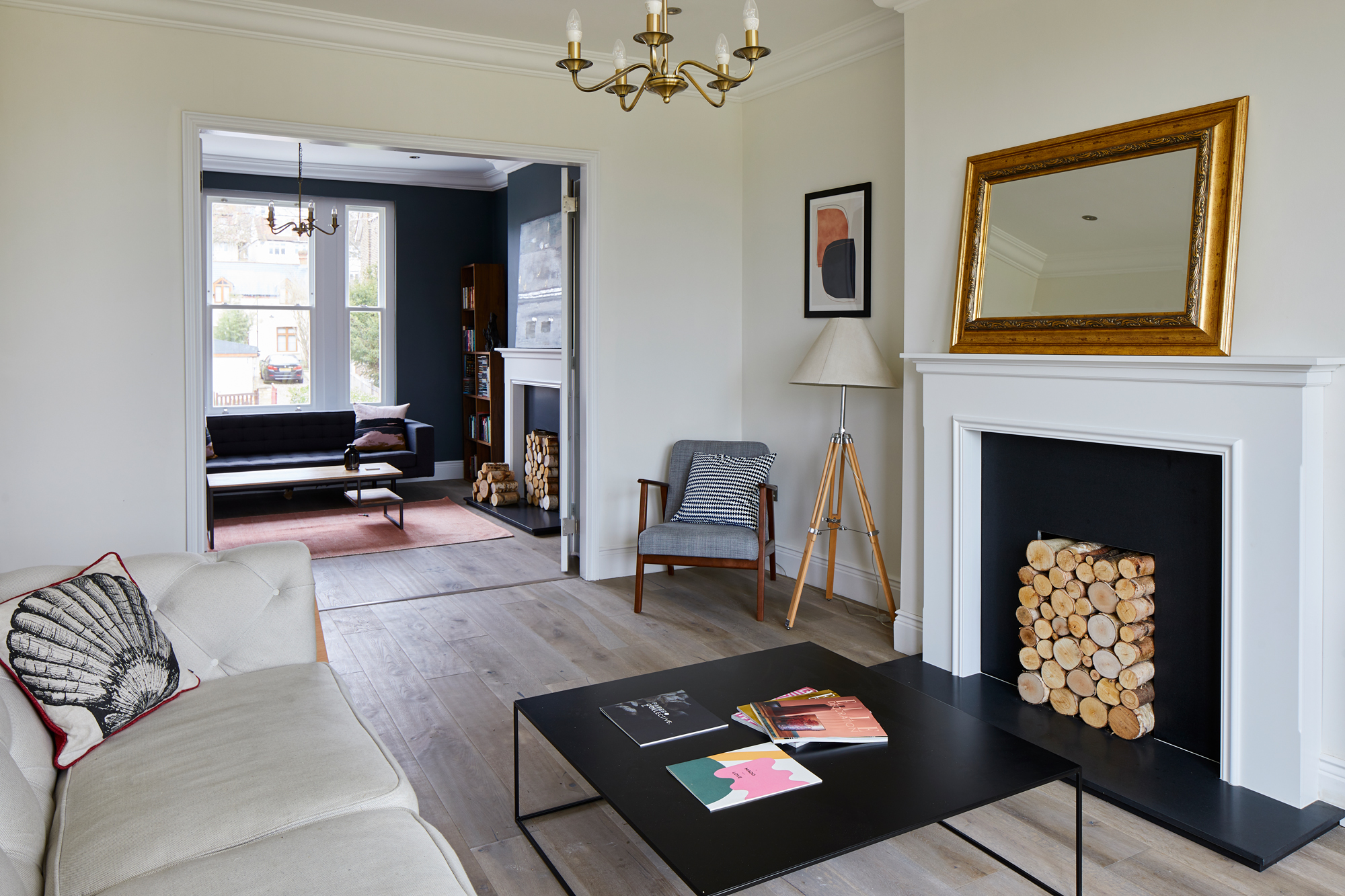Removing a chimney breast: What you need to know
Removing a chimney breast offers a trade off — extra space for original features — that's worthwhile for the right home. Here's everything you need to know, from cost to structural implications

Removing a chimney breast is the right solution for some homes. While you may want to make every effort to conserve period features, if a chimney breast is not providing roaring fires to sit beside, they can be a bit of a nuisance — bulky and, in some cases, downright ugly.
For those looking to remove a chimney breast, it’s important to remember there are regulations to consider during the renovation process, even if yours isn’t in use.
An internal chimney breast can be removed at ground and/or first floor without having to remove the external stack. No only does this mean it is actually not as disruptive as you might have thought, but it also avoids the need to alter the roof or external appearance and character of the building.
Bear in mind that you only remove sections of the chimney. Anything remaining above, such as the stack, will need to be supported. Or, if you decide the stack needs to go as well, find out what your chimney stack removal costs might be before making a final decision.
(MORE: Renovating a House)
Is Removing a Chimney Breast Difficult?
For even more advice, information and inspiration delivered straight to your door, subscribe to Homebuilding & Renovating magazine.
Removing a chimney breast internally is a mess job. It will create lots of dust and debris, so the room should be cleared and sealed off from the rest of the property as much as possible. External chimney stack removal can be done from outside the building and, if done carefully, need not disrupt any internal decoration.
An internal chimney breast can be removed at ground and/or first floor without having to remove the external stack. No only does this mean it is actually not as disruptive as you might have thought, but it also avoids the need to alter the roof or external appearance and character of the building.
Bring your dream home to life with expert advice, how to guides and design inspiration. Sign up for our newsletter and get two free tickets to a Homebuilding & Renovating Show near you.
Remember too that any gas, plumbing or electrical services for existing or old heating appliances to be removed should be isolated and altered before you begin.
If upper sections of the chimney are being retained, they will need to be supported using strongboys on steel acrow props before removing the structure below. This support should be kept in place until the new permanent support, designed by a structural engineer, is in place.

On the ground floor, the stack should be taken down to ground level. Ensure suitable damp prevention measures are in place, something that will depend on whether you have a concrete or timber subfloor structure. Any voids in the wall, floor and ceilings will need to be filled and made good.
Once the structural work is complete, walls will need replastering and decorating. The flooring may also need updating to fill the reclaimed space.
Is a Chimney Breast Load Bearing?
Make sure your budget factors in hiring a structural engineer, who’ll be required to ensure your property’s structural integrity.
For some homes, the removal of a chimney doesn’t necessarily affect the strength of your walls. Even so, your local authority will want proof that this is the case.
Bear in mind that you only remove sections of the chimney. Anything remaining above, such as the stack, will need to be supported If you plan on removing a chimney from the ground floor, but not from the rest of the property, your engineer will need to provide specifications to support the remaining stack.
If the chimney and the stack are all fully removed, including above roof level, there should be no need for extra structural supports, which your engineer will also confirm.

How Much Does it Cost to Remove a Chimney Breast?
The cost of removing the chimney breast will be mainly dictated by the structural solution. As a starting point, it's recommended you budget at least £5,000 for this project.
If you’re trying to work out a more tailored quote, make sure you’re taking into account the cost of demolition, professional fees, installation of structural steel beams, plus redecoration of the affected areas.
Here's some estimates for removing a chimney breast depending on the property:
- Ground or first floor chimney breast only: £1,400-2,400 plus VAT
- External stack: £1,000-2,000 plus VAT
- Full chimney in a two-storey property: £2,800–3,800 plus VAT
How Long Does it Take to Remove a Chimney Stack

Need more advice or inspiration for your project? Get two free tickets to the Homebuilding & Renovating Show
Expect removing a chimney stack to take one-two weeks.
Do I Need Planning Permission to Remove a Chimney Breast?
No. Planning permission is not required for internal alterations, like removing a chimney breast, as they don’t constitute development. However, it’s an offence to make alterations to a listed building without first obtaining listed building consent.
The removal of an external chimney will usually be classed as Permitted Development (PD) and automatically have planning permission. PD rights only apply to dwelling houses and not to flats. PD rights can be removed or restricted for properties in a conservation area or national park, so check before undertaking work.
Building Regulations for Removing a Chimney Breast
When removing a chimney, you’ll need to make sure the structural works comply with Part A of UK Building Regulations. You can tackle this issue either by notifying your local authority and being assigned a building control officer or by hiring an approved inspector.
If speed is of the essence, going for an approved inspector is usually the fastest way to get your paperwork in order. Once your project has been completed, no matter which route you took, you’ll be issued a certificate to prove all legal requirements have been me. The fee is around £200-220 plus VAT.
You'll also need to meet the following regulations:
- Party Wall Act (England and Wales): If no party structures are affected by the removal or by any new structural supports (if the stack is only partially removed), there will be no need to serve party wall notice. However, if the chimney is built against a party wall, it is always recommended to work with a party wall surveyor to see if any of the works (including the structural support, if needed) require a notice to be served. Budget £700-800 plus VAT per neighbour affected.
- Permission from the freeholder: For leasehold properties, permission for alterations will usually require a landlord licence giving consent to the works. For a shared freehold, the other owners will need to agree to the works.
- Gas: Remember that any work involving the alteration of a gas appliance or its components has to be undertaken by a Gas Safe Register engineer. After completing the works, a certificate, in accordance with the self-certification scheme, should be issued to the property owner.
Michael is Homebuilding & Renovating's Director of Content, Vice Chair of the self build industry body, the National Custom and Self Build Association (NaCSBA), presenter of multiple property TV shows and author of Renovating for Profit (Ebury). He also runs an architectural and interior design practice, offering design and project management services. He is one of the country's leading property experts and has undertaken over 30 building projects including two self-builds and the renovation of a Grade-II listed farmhouse.
Michael has presented over 150 property shows for BBC, ITV1, Channel 5, UK TV Style, and Discovery RealTime, including I Own Britain's Best Home; Don't Move Improve; Trading Up; Good Bid, Good Buy; Build, Buy or Restore?; How to Build A House; and Hard Sell.
Michael is also a regular expert at the Homebuilding & Renovating Shows. He has written for leading British newspapers, including The Daily Telegraph, Sunday Times, Daily Express and The Independent and has appeared on news programmes such as BBC Breakfast.

